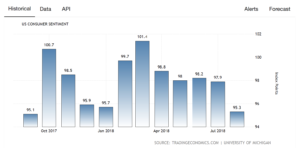Economic indicators such as unemployment rates, the U6 number and the consumer price index are key insights into analyzing the economy. Experts are constantly studying what is going on in both the global economy and economies of specific countries in order to understand current economic states. This allows individuals to make educated predictions about the future of these economies. Often the most important indicators to look at are not those providing data of what is happening now or the spending that is taking place currently, but rather indicators that forecast future trends. These indicators are called leading indicators – one being consumer confidence.
Consumer confidence measures how optimistic consumers are feeling about the current state of the economy, as well as their own personal financial situation. The index is based on a monthly survey of thousands of United States households. The survey is put on by The Conference Board and consists of five questions surrounding topics like current business conditions, business conditions for the next six months, current employment conditions, employment conditions for the next six months and total family income for the next six months. Opinion on current conditions makes up around 40 percent of the index and expectation about the future makes up around 60 percent. The primary focus on the future is what categorizes consumer confidence as a leading indicator, as opposed to a trailing indicator like retail sales.
While this economic indicator specifies consumer sentiment, it has the powerful ability predict consumer spending. Consumer confidence will directly point to whether individuals are likely to go to the mall on the weekend to do some leisurely shopping, or if they will only be focusing on fulfilling only their basic needs. In turn, it aids experts and other consumers in understanding where the general population feels the economy is going – arguably the most important insight into a nation.
Normality of consumer confidence is measured at 100. In August 2018, consumer confidence in the United States was the lowest in almost a year, falling from 97.9 in July to 95.3. A graph tracking consumer confidence in the U.S. over the last year is shown below:
Experts are estimating the low reading is mainly due to less favorable perceptions of market prices. Additionally, consumers reported viewing vehicle and home-buying conditions as less favorable. There is evidence that consumers have become very sensitive to even low inflation rates, as they were anticipating a 2.9 % inflation rate ahead of August.
This fall in consumer confidence will likely reflect in next month’s retail sales and personal spending numbers. Aware of the effect of this economic indicator, corporations as well as politicians utilize consumer confidence to anticipate whether people will be likely spending more or saving more in upcoming months. Businesses are able to adjust operational plans as a result of the indicator, either increasing or decreasing volume production of their product. Additionally, the government can adjust their expected tax revenue based on consumer spending.
It is essential to pay attention to consumer confidence. It allows consumers and experts in economics to make proactive decisions regarding the economy. The economic indicator also provides valuable insight into the certainty citizen’s feel about their nation.

Leave a Reply
You must be logged in to post a comment.